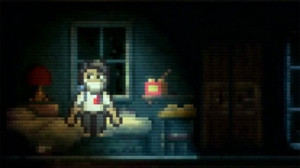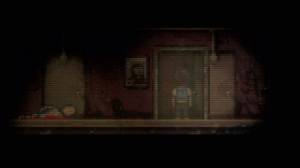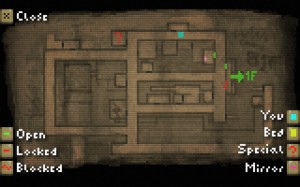Spooky Scenes, Frustrating World.
Lone Survivor: Director’s Cut
Superflat Games | PS Vita | September 24, 2013
Also Available for PS3, PC, OSX and Linux
 Survival horror goes 2D in this psychological thriller made by Jasper Byrne. Players control “You” the last man alive in a side scrolling, pixel art apocalypse where food is scarce, zombies are everywhere and what you see might not actually be there.
Survival horror goes 2D in this psychological thriller made by Jasper Byrne. Players control “You” the last man alive in a side scrolling, pixel art apocalypse where food is scarce, zombies are everywhere and what you see might not actually be there.
You starts off in his apartment building but must venture out in hopes of finding other survivors and supplies. While foraging, his body will require food and sleep. Failure to meet these necessities will send You further into madness. It’s not just the flesh eating zombies that threaten survival but the environment itself.
What is a Critical Hit!
The game encourages players to be fully immersed in the experience during the initial load screen; turn off the lights, use headphones and be free from distractions. Lone Survivor does an amazing job setting the tone and making the most out of the assets available. Substituting AAA over the top graphics for a clean indie graphics allows the game to focus on what it does best, sound.
The sound effects in this game are fantastic and set the mood of the abandoned apartment. You’s and the zombie’s footsteps echo in the hallways, zombies groan differently to signal an attack and as the player’s health drops his failing heartbeat cuts through the music. The tension is added by an eerie soundtrack that shifts tones while exploring, combat or dialogue scenes. Lone Survivor’s soundtrack uses 8-bit style tones which retro-gamers will enjoy and win over modern players.
Lone Survivor’s excellent sound work is matched by the character design and usage of a simple flashlight. You runs around with a medical mask covering his mouth, but it looks like he has a giant goofy grin. There is a true sense of Macomb madness as he scurries behind a zombie with this large smile plastered on his face. The flashlight mechanic creates a balance of risk versus reward in  exploration. Players can see more of the environment with the light on, but it will attract zombies quickly. Some areas do not require the light to be on, whereas others will be pitch black without any other source. It is not obvious if the light will help You reach safety or become a beacon for a zombie feast.
exploration. Players can see more of the environment with the light on, but it will attract zombies quickly. Some areas do not require the light to be on, whereas others will be pitch black without any other source. It is not obvious if the light will help You reach safety or become a beacon for a zombie feast.
You is extremely fragile, only able to absorb a couple bites before collapsing. This emphasis on survival turns zombie encounters into a puzzle instead of an action adventure game. Health can be regenerated by sleeping through the night or eating scavenged food. There is no formal health bar, instead players know You’s state by the redness on the screen and audible cues. This immersion is a welcomed change from the shoot-em up zombie games on the market.
Supplies are limited, leaving players with a sense of helplessness rather quickly. The flashlight does not run on rechargeable batteries, there is a finite amount of medicine and there are more zombies than food. To add to the tension, the only save point is back at the starting apartment. You is able to utilize dusty mirrors which will transport him home, and back to the last spot visited. The limited usage of save points reminds me of the printer ribbons from Resident Evil and the lack of supplies mean that players can paint themselves in a corner where they will be under-equipped to deal with each room they encounter.
What is Not Very Effective…
The side scrolling exploration is an interesting design choice that works for each individual frame, unfortunately the game’s map is an overhead view that doesn’t match the on-screen presentation. Walking towards the right of the screen could be the equivalent of heading north, south or west on the map (ironically, never east that I noticed). Finding the next room quickly becomes a trial and error exercise. The player will need to open the map constantly to determine if they are heading in the right direction. The map  attempts to indicate what paths are open or blocked, but this is not always indicative of the current situation as You might have the proper tool to push forward.
attempts to indicate what paths are open or blocked, but this is not always indicative of the current situation as You might have the proper tool to push forward.
The game lacks a definitive course for where You should go next. This can help create tension and there doesn’t need to be a giant compass pointing to the next spot, but if you are running around wasting supplies and time it becomes frustrating. The puzzle mechanics are not fully explained or make logical sense. In an early puzzle, there was monster puss blocking passage in a tunnel. The game hinted that I needed to go back to the beginning and explore. Little did I realize that all I needed was a pair of scissors to cut through the wall (apparently the other tools and handgun wouldn’t suffice). This wouldn’t have been so bad if the game hinted that the scissors would work or if when I returned to the wall, interacted with it, that the door would open. But I had to actively open my bag and go through everything to determine that this was the correct course of action.
To add to the confusion of the open world, most of the areas look the same. The environments feel recycled and have the same elements. The color palette does an amazing job setting the mood and terror of the game, but does no favors when trying to distinguish the individual rooms.
You is not completely helpless, he discovers a handgun early in the game. But he might as well not. Ammo is scarce and zombies require multiple shots to fall. The game provides plenty of non-lethal opportunities to survive that are more in sync with the story they are trying to tell.
Status Summary
Lone Survivor is a throwback to survival horror games where resources are scarce, the protagonist is weak and the environment is creates a spectacular spooky scene. Horror fans will rejoice at the game’s excellent usage of music, sound effects and lighting to create a psychological thrill.
I spent too much time wondering around aimlessly; found the interface frustrating and the mysterious scenes to be more distracting than engaging. I can see why fans of the genre would enjoy this game but could not recommend it to anyone who just wanted to play for a few hours. The exploration leaves a lot to be desired, the character referred to as “You” is a ham fisted way to draw the player in (which is surprising because the environment does a good job of this on its own) and the menu navigation is a chore.
If you enjoy survival horror games and want to immerse yourself in a psychological adventure than this game is a worthy companion. If you prefer exploration to be defined and the rules fleshed out then you should leave this game alone.
Likelihood to Complete: 0%
Likelihood to Platinum: 0%
Trophy Analysis
I played the game for about an hour and half and did not earn a single trophy While reviewing the list, apparently there are multiple trophies for various endings and beating the game on expert. Each run of the game would take about 5 hours, meaning that the entire collection should take approximately 20+ hours (of course you might be faster each time and able to shave some time off). Trophies are only earned after meeting the criteria and sleeping for the night. According to Sony’s Playstation App, most of the trophies are earned by less than 1% of players, with the highest completion percentage for a single trophy at 8.9%.
Level Up, Friends!
